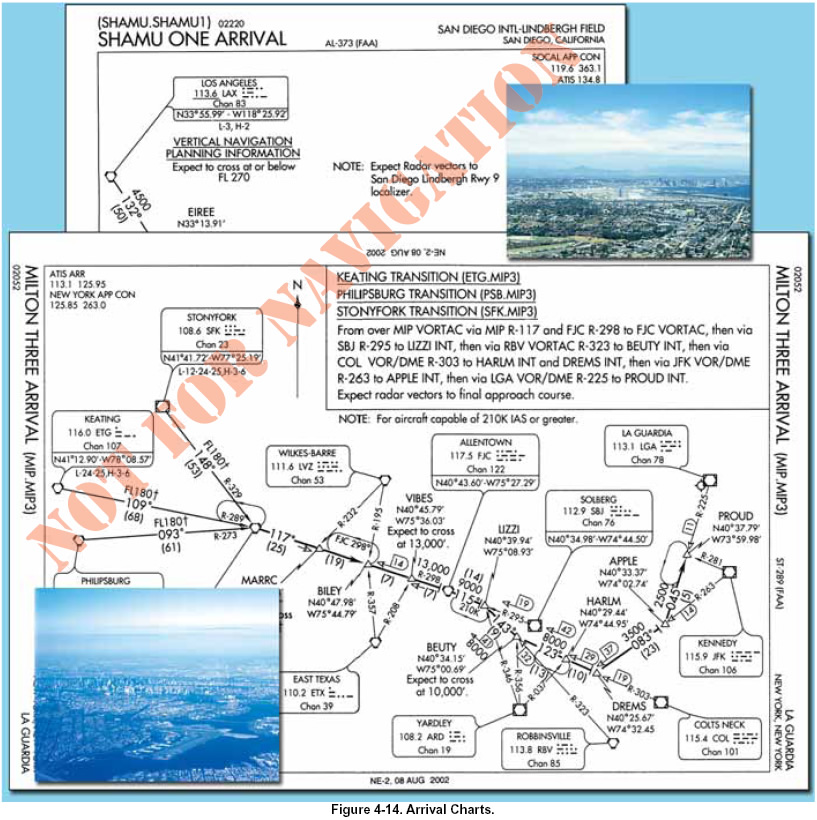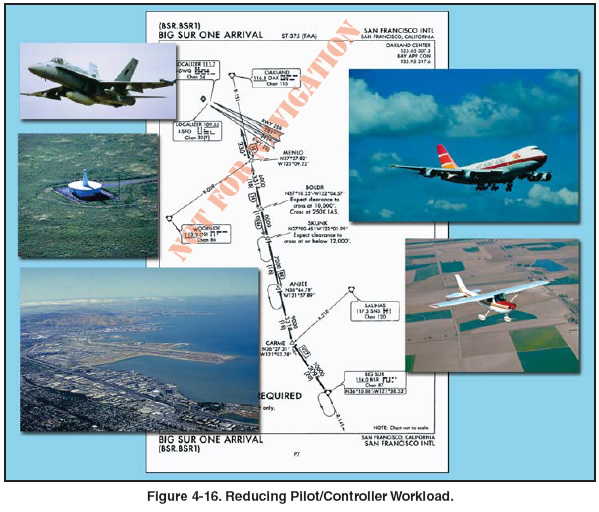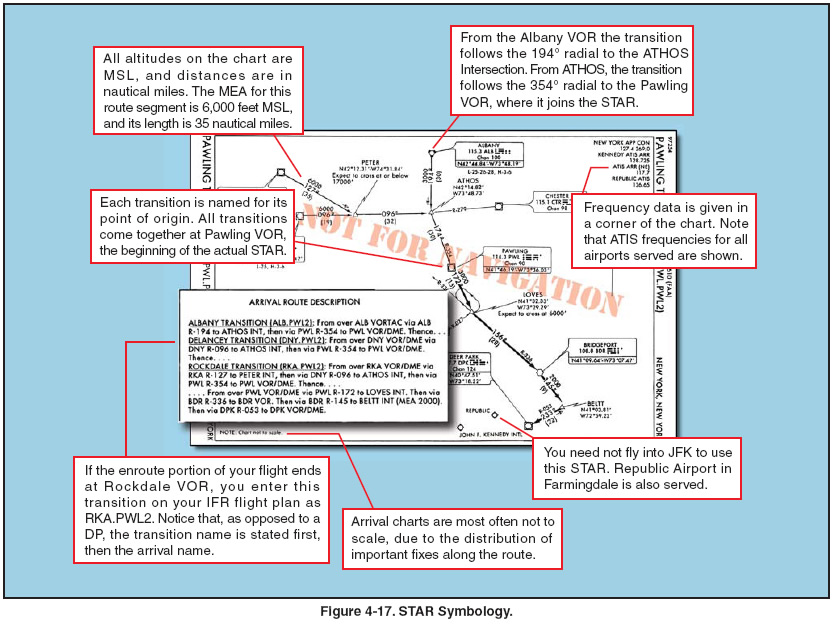 |
|
| INSTRUMENT PROCEDURES HANDBOOK |
|
STANDARD TERMINAL ARRIVAL ROUTES A standard terminal arrival route (STAR) provides a critical form of communication between pilots and ATC. Once a flight crew has accepted a clearance for a STAR, they have communicated with the controller what route, and in some cases what altitude and airspeed, they will fly during the arrival, depending on the type of clearance. The STAR provides a common method for leaving the en route structure and navigating to your destination. It is a preplanned instrument flight rule ATC arrival procedure published for pilot use in graphic and textual form that simplifies clearance delivery procedures. When the repetitive complex departure clearances by controllers turned into standard instrument departures (SIDs) in the late 1970s, the idea caught on quickly. Eventually, most of the major airports in the U.S. developed standard departures with graphics for printed publication. The idea seemed so good that the standard arrival clearances also started being published in text and graphic form. The new procedures were named standard terminal arrival routes, or STARs. The principal difference between SIDs or departure procedures (DPs) and STARs is that the DPs start at the airport pavement and connect to the en route structure. STARs on the other hand, start at the en route structure but don’t make it down to the pavement; they end at a fix or NAVAID designated by ATC, where radar vectors commonly take over. This is primarily because STARs serve multiple airports. STARs greatly help to facilitate the transition between the en route and approach phases of flight. The objective when connecting a STAR to an instrument approach procedure is to ensure a seamless lateral and vertical transition. The STAR and approach procedure should connect to one another in such a way as to maintain the overall descent and deceleration profiles. This often results in a seamless transition between the en route, arrival, and approach phases of flight, and serves as a preferred route into high volume terminal areas. [Figure 4-14 on page 4-16]
STARs provide a transition from the en route structure to an approach gate, outer fix, instrument approach fix, or arrival waypoint in the terminal area, and they usually terminate with an instrument or visual approach procedure. STARs are included at the front of each Terminal Procedures Publication regional booklet. For STARs based on conventional NAVAIDs, the procedure design and obstacle clearance criteria are essentially the same as that for en route criteria, covered in Chapter 3, En Route Operations. STAR procedures typically include a standardized descent gradient at and above 10,000 feet MSL of 318 feet per NM, or 3 degrees. Below 10,000 feet MSL the maximum descent rate is 330 feet per NM, or approximately 3.1 degrees. In addition to standardized descent gradients, STARs allow for deceleration segments at any waypoint that has a speed restriction. As a general guideline, deceleration considerations typically add 1 NM of distance for each ten knots of speed reduction required. INTERPRETING THE STAR STARs use much of the same symbology as departure and approach charts. In fact, a STAR may at first appear identical to a similar graphic DP, except the direction of flight is reversed and the procedure ends at an approach fix. The STAR officially begins at the common NAVAID, intersection, or fix where all the various transitions to the arrival come together. A STAR transition is a published segment used to connect one or more en route airways, jet routes, or RNAV routes to the basic STAR procedure. It is one of several routes that bring traffic from different directions into one STAR. This way, arrivals from several directions can be accommodated on the same chart, and traffic flow is routed appropriately within the congested airspace. To illustrate how STARs can be used to simplify a complex clearance and reduce frequency congestion, consider the following arrival clearance issued to a pilot flying to Seattle, Washington, depicted in Figure 4-15 on page 4-17: “Cessna 32G, cleared to the Seattle/Tacoma International Airport as filed. Maintain 12,000. At the Ephrata VOR intercept the 221° radial to CHINS Intersection. Intercept the 284° radial of the Yakima VOR to RADDY Intersection. Cross RADDY at 10,000. Continue via the Yakima 284° radial to AUBRN Intersection. Expect radar vectors to the final approach course.”
Now consider how this same clearance is issued when a STAR exists for this terminal area. “Cessna 32G, cleared to Seattle/Tacoma International Airport as filed, then CHINS FOUR ARRIVAL, Ephrata Transition. Maintain 10,000 feet.” A shorter transmission conveys the same information. Safety is enhanced when both pilots and controllers know what to expect. Effective communication increases with the reduction of repetitive clearances, decreasing congestion on control frequencies. To accomplish this, STARs are developed according to the following criteria:
STARs usually are named according to the point at which the procedure begins. In the U.S., typically there are en route transitions before the STAR itself. So the STAR name is usually the same as the last fix on the en route transitions where they come together to begin the basic STAR procedure. A STAR that commences at the CHINS Intersection becomes the CHINS ONE ARRIVAL. When a significant portion of the arrival is revised, such as an altitude, a route, or data concerning the NAVAID, the number of the arrival changes. For example, the CHINS ONE ARRIVAL is now the CHINS FOUR ARRIVAL due to modifications in the procedure. Studying the STARs for an airport may allow you to perceive the specific topography of the area. Note the initial fixes and where they correspond to fixes on the NACO en route or area chart. Arrivals may incorporate stepdown fixes when necessary to keep aircraft within airspace boundaries, or for obstacle clearance. Routes between fixes contain courses, distances, and minimum altitudes, alerting you to possible obstructions or terrain under your arrival path. Airspeed restrictions also appear where they aid in managing the traffic flow. In addition, some STARs require that you use DME and/or ATC radar. You can decode the symbology on the PAWLING TWO ARRIVAL depicted in Figure 4-17 on page 4-18 by referring to the legend at the beginning of the NACO Terminal Procedures Publication.
|



